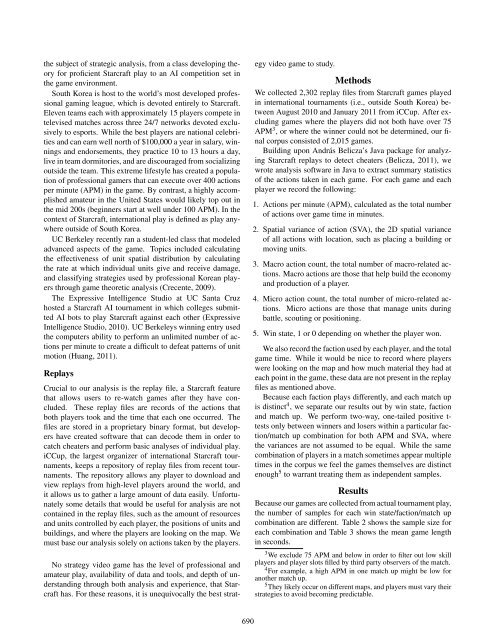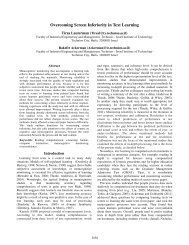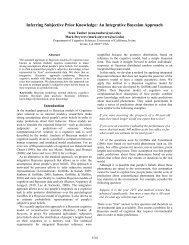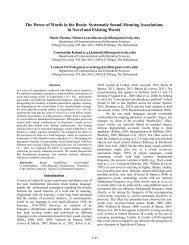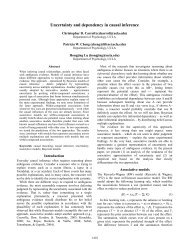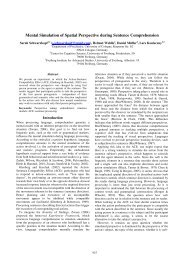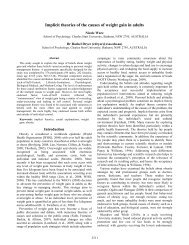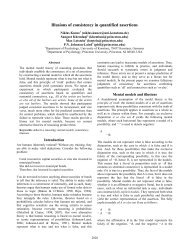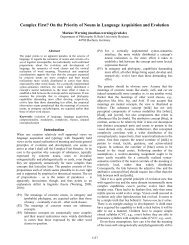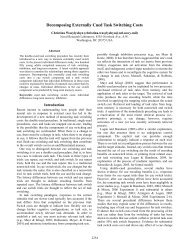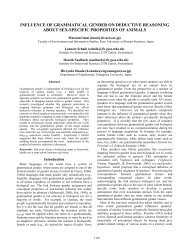A Corpus Analysis of Strategy Video Game Play in Starcraft: Brood ...
A Corpus Analysis of Strategy Video Game Play in Starcraft: Brood ...
A Corpus Analysis of Strategy Video Game Play in Starcraft: Brood ...
Create successful ePaper yourself
Turn your PDF publications into a flip-book with our unique Google optimized e-Paper software.
the subject <strong>of</strong> strategic analysis, from a class develop<strong>in</strong>g theory<br />
for pr<strong>of</strong>icient <strong>Starcraft</strong> play to an AI competition set <strong>in</strong><br />
the game environment.<br />
South Korea is host to the world’s most developed pr<strong>of</strong>essional<br />
gam<strong>in</strong>g league, which is devoted entirely to <strong>Starcraft</strong>.<br />
Eleven teams each with approximately 15 players compete <strong>in</strong><br />
televised matches across three 24/7 networks devoted exclusively<br />
to esports. While the best players are national celebrities<br />
and can earn well north <strong>of</strong> $100,000 a year <strong>in</strong> salary, w<strong>in</strong>n<strong>in</strong>gs<br />
and endorsements, they practice 10 to 13 hours a day,<br />
live <strong>in</strong> team dormitories, and are discouraged from socializ<strong>in</strong>g<br />
outside the team. This extreme lifestyle has created a population<br />
<strong>of</strong> pr<strong>of</strong>essional gamers that can execute over 400 actions<br />
per m<strong>in</strong>ute (APM) <strong>in</strong> the game. By contrast, a highly accomplished<br />
amateur <strong>in</strong> the United States would likely top out <strong>in</strong><br />
the mid 200s (beg<strong>in</strong>ners start at well under 100 APM). In the<br />
context <strong>of</strong> <strong>Starcraft</strong>, <strong>in</strong>ternational play is def<strong>in</strong>ed as play anywhere<br />
outside <strong>of</strong> South Korea.<br />
UC Berkeley recently ran a student-led class that modeled<br />
advanced aspects <strong>of</strong> the game. Topics <strong>in</strong>cluded calculat<strong>in</strong>g<br />
the effectiveness <strong>of</strong> unit spatial distribution by calculat<strong>in</strong>g<br />
the rate at which <strong>in</strong>dividual units give and receive damage,<br />
and classify<strong>in</strong>g strategies used by pr<strong>of</strong>essional Korean players<br />
through game theoretic analysis (Crecente, 2009).<br />
The Expressive Intelligence Studio at UC Santa Cruz<br />
hosted a <strong>Starcraft</strong> AI tournament <strong>in</strong> which colleges submitted<br />
AI bots to play <strong>Starcraft</strong> aga<strong>in</strong>st each other (Expressive<br />
Intelligence Studio, 2010). UC Berkeleys w<strong>in</strong>n<strong>in</strong>g entry used<br />
the computers ability to perform an unlimited number <strong>of</strong> actions<br />
per m<strong>in</strong>ute to create a difficult to defeat patterns <strong>of</strong> unit<br />
motion (Huang, 2011).<br />
Replays<br />
Crucial to our analysis is the replay file, a <strong>Starcraft</strong> feature<br />
that allows users to re-watch games after they have concluded.<br />
These replay files are records <strong>of</strong> the actions that<br />
both players took and the time that each one occurred. The<br />
files are stored <strong>in</strong> a proprietary b<strong>in</strong>ary format, but developers<br />
have created s<strong>of</strong>tware that can decode them <strong>in</strong> order to<br />
catch cheaters and perform basic analyses <strong>of</strong> <strong>in</strong>dividual play.<br />
iCCup, the largest organizer <strong>of</strong> <strong>in</strong>ternational <strong>Starcraft</strong> tournaments,<br />
keeps a repository <strong>of</strong> replay files from recent tournaments.<br />
The repository allows any player to download and<br />
view replays from high-level players around the world, and<br />
it allows us to gather a large amount <strong>of</strong> data easily. Unfortunately<br />
some details that would be useful for analysis are not<br />
conta<strong>in</strong>ed <strong>in</strong> the replay files, such as the amount <strong>of</strong> resources<br />
and units controlled by each player, the positions <strong>of</strong> units and<br />
build<strong>in</strong>gs, and where the players are look<strong>in</strong>g on the map. We<br />
must base our analysis solely on actions taken by the players.<br />
No strategy video game has the level <strong>of</strong> pr<strong>of</strong>essional and<br />
amateur play, availability <strong>of</strong> data and tools, and depth <strong>of</strong> understand<strong>in</strong>g<br />
through both analysis and experience, that <strong>Starcraft</strong><br />
has. For these reasons, it is unequivocally the best strat-<br />
690<br />
egy video game to study.<br />
Methods<br />
We collected 2,302 replay files from <strong>Starcraft</strong> games played<br />
<strong>in</strong> <strong>in</strong>ternational tournaments (i.e., outside South Korea) between<br />
August 2010 and January 2011 from iCCup. After exclud<strong>in</strong>g<br />
games where the players did not both have over 75<br />
APM 3 , or where the w<strong>in</strong>ner could not be determ<strong>in</strong>ed, our f<strong>in</strong>al<br />
corpus consisted <strong>of</strong> 2,015 games.<br />
Build<strong>in</strong>g upon András Belicza’s Java package for analyz<strong>in</strong>g<br />
<strong>Starcraft</strong> replays to detect cheaters (Belicza, 2011), we<br />
wrote analysis s<strong>of</strong>tware <strong>in</strong> Java to extract summary statistics<br />
<strong>of</strong> the actions taken <strong>in</strong> each game. For each game and each<br />
player we record the follow<strong>in</strong>g:<br />
1. Actions per m<strong>in</strong>ute (APM), calculated as the total number<br />
<strong>of</strong> actions over game time <strong>in</strong> m<strong>in</strong>utes.<br />
2. Spatial variance <strong>of</strong> action (SVA), the 2D spatial variance<br />
<strong>of</strong> all actions with location, such as plac<strong>in</strong>g a build<strong>in</strong>g or<br />
mov<strong>in</strong>g units.<br />
3. Macro action count, the total number <strong>of</strong> macro-related actions.<br />
Macro actions are those that help build the economy<br />
and production <strong>of</strong> a player.<br />
4. Micro action count, the total number <strong>of</strong> micro-related actions.<br />
Micro actions are those that manage units dur<strong>in</strong>g<br />
battle, scout<strong>in</strong>g or position<strong>in</strong>g.<br />
5. W<strong>in</strong> state, 1 or 0 depend<strong>in</strong>g on whether the player won.<br />
We also record the faction used by each player, and the total<br />
game time. While it would be nice to record where players<br />
were look<strong>in</strong>g on the map and how much material they had at<br />
each po<strong>in</strong>t <strong>in</strong> the game, these data are not present <strong>in</strong> the replay<br />
files as mentioned above.<br />
Because each faction plays differently, and each match up<br />
is dist<strong>in</strong>ct 4 , we separate our results out by w<strong>in</strong> state, faction<br />
and match up. We perform two-way, one-tailed positive ttests<br />
only between w<strong>in</strong>ners and losers with<strong>in</strong> a particular faction/match<br />
up comb<strong>in</strong>ation for both APM and SVA, where<br />
the variances are not assumed to be equal. While the same<br />
comb<strong>in</strong>ation <strong>of</strong> players <strong>in</strong> a match sometimes appear multiple<br />
times <strong>in</strong> the corpus we feel the games themselves are dist<strong>in</strong>ct<br />
enough 5 to warrant treat<strong>in</strong>g them as <strong>in</strong>dependent samples.<br />
Results<br />
Because our games are collected from actual tournament play,<br />
the number <strong>of</strong> samples for each w<strong>in</strong> state/faction/match up<br />
comb<strong>in</strong>ation are different. Table 2 shows the sample size for<br />
each comb<strong>in</strong>ation and Table 3 shows the mean game length<br />
<strong>in</strong> seconds.<br />
3 We exclude 75 APM and below <strong>in</strong> order to filter out low skill<br />
players and player slots filled by third party observers <strong>of</strong> the match.<br />
4 For example, a high APM <strong>in</strong> one match up might be low for<br />
another match up.<br />
5 They likely occur on different maps, and players must vary their<br />
strategies to avoid becom<strong>in</strong>g predictable.


